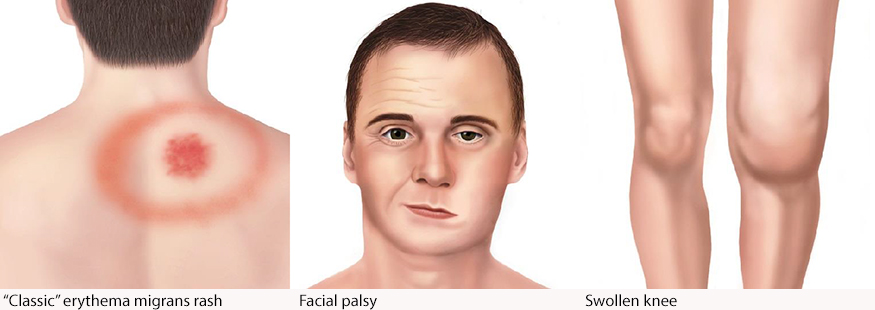This post is by Bernie Carr, apartmentprepper.com
A friend of ours took his family on a camping trip for some summer fun. They were enjoying the outdoors, taking hikes when he suddenly had to cut his trip short – he ended up in the hospital. As he was hiking, he brushed against a bush that was infested with hundreds of ticks that embedded themselves all over him. Apparently, it was so bad the family could not get the ticks off fast enough and he had to go to the emergency room at the nearest hospital. He was tested for disease before he got discharged. The tests appeared negative at the time, but after a few weeks he found out that he got Lyme disease.
What is Lyme Disease?
Lyme disease is spread from ticks: the victim experiences a severe headache, fever, extreme fatigue, paralysis in the face (facial palsy) swelling and pain in the joints, and a skin rash called erythema migrans. The rash looks like a bulls-eye: a roundish red rash with a large circle around it.

Treatment involves taking antibiotics, which are effective if you start taking them soon enough. The problem is, many people don’t even know they have caught it as the symptoms can take several weeks to appear after the initial bite. If you don’t treat it, the disease can spread to your joints, heart, and nervous system. Some people describe feeling symptoms for months, even years. The condition is known as chronic Lyme disease or post-treatment Lyme disease syndrome.
Prior to hearing about what happened to our friends, I had not given ticks a lot of thought. But as I read more about it, I realized ticks can really hurt people and animals.
- They can easily attach to clothing and pets from the outside and infest your home.
- Ticks are active in warm weather – late spring and summer.
- They survive by feeding off animal or human blood. They transmit disease while feeding off the host.
- Lyme disease is not the only thing you can pick up from ticks. Other diseases include Rocky Mountain spotted fever, Anaplasmosis, Babesiosis and many others. I am not a medical professional so for more information, check here
- Ticks can be found in grassy, wooded areas that have dense vegetation
- Female ticks can lay up to 11,000 eggs!
How to Avoid Picking Up Ticks
- Walk in the middle of trails
- Avoid high grass and heavily wooded areas.
- Choose light-colored clothing to allow you to easily spot ticks that get on you.
- If you cannot avoid it, take precautions by tucking your pant legs into your boots and tuck your shirt into your pants.
- For extra protection, wound duct tape around any vulnerable areas. Wound around once then twist and expose the sticky side. I know, not very attractive but I am willing to try it. See photo above.
- Use insect repellents containing 20% DEET on exposed skin. Some of our readers swear by Natrapel
- Spray gear and camping equipment such as tents and backpacks with products containing permethrin. We have gotten good results from Sawyer Permethrin Insect Spray.
- When returning from wooded areas, inspect clothes and shoes before heading indoors – inspect yourself, children and pets for any “hitchhiking” ticks. Be as thorough as possible – ticks are so small they could look like a spec of dust or a tiny mole.
- If you have pets, discuss tick prevention programs with your vet.
- Take a shower as soon as possible.
How to Remove a Tick
- Use fine-tipped tweezers.
- Grab the tick with the tweezers as close as possible to the skin.
- Pull upward firmly but do not twist. Twisting may cause pieces of the tick’s mouth to be left on the skin. If anything gets left behind, pull out with the tweezers.
- After removal, cleanse the area and your hands with alcohol, iodine wash, or soap and water
Seek Medical Attention if:
- You are unable to remove the tick. This is what happened to the friend I mentioned.
- Worsening rash
- Persistent headache
- Fever
- Lethargy/Confusion
- Paralysis
- Vomiting
- Difficulty breathing
- Heart palpitations
This summer is turning out to be quite a bug-infested season. If they can cause this much misery during “normal” times, imagine how much worse it could get during a disaster or emergency.
© Apartment Prepper 2016


Thank goodness they came right off with DEET! Thanks for sharing the story.
Yikes, those ticks are insidious! We are paranoid about them as well, I’d hate to get one and not see it right away. Thanks for the comments JL!
Sometimes the rash does not appear. My daughter contracted it a few months ago and never showed a rash. She started having joint pain and tiredness no we out 2 and 2 together. I myself had full-blown Lyme three summers ago. It was absolutely awful. Take precautions. Check yourself over after returning indoors.
Hi Drew, That is good to know. Thought a rash would always appear. Thanks for sharing this!